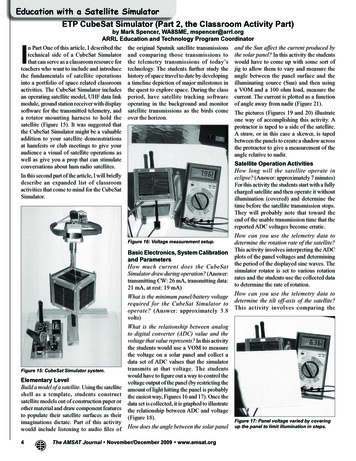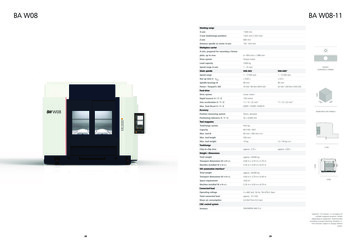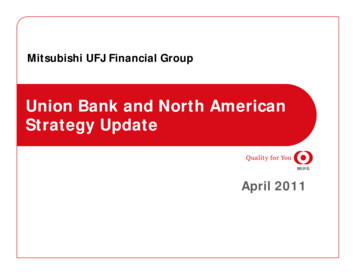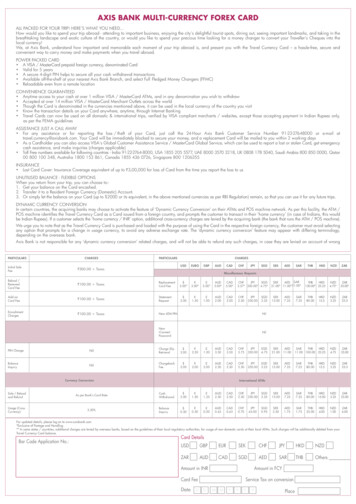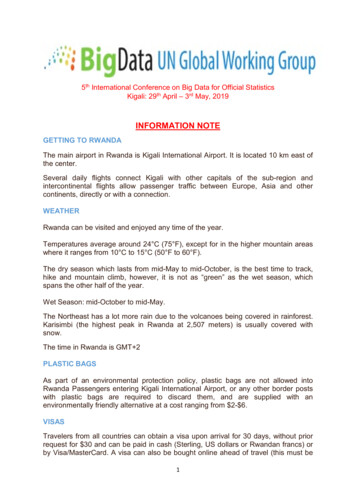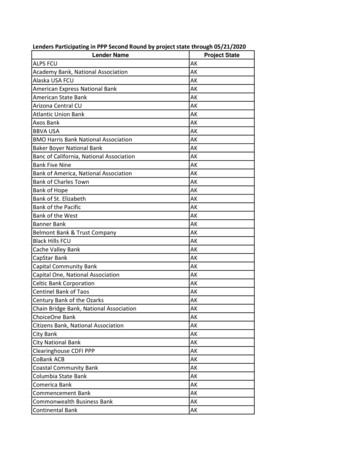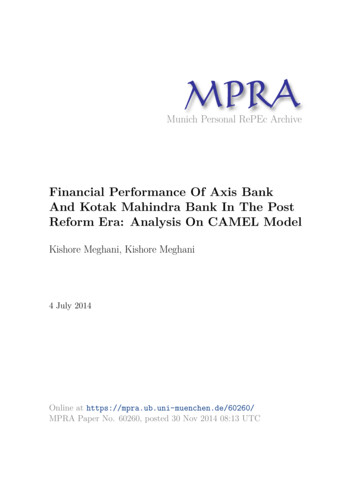
Transcription
Munich Personal RePEc ArchiveFinancial Performance Of Axis BankAnd Kotak Mahindra Bank In The PostReform Era: Analysis On CAMEL ModelKishore Meghani, Kishore Meghani4 July 2014Online at https://mpra.ub.uni-muenchen.de/60260/MPRA Paper No. 60260, posted 30 Nov 2014 08:13 UTC
FINANCIAL PERFORMANCE OF AXIS BANK AND KOTAK MAHINDRA BANK INTHE POST REFORM ERA: ANALYSIS ON CAMEL MODEL.* Deepti Tripathi** Kishore Meghani***Swati MahajanAbstract:The objective of this study is to Analyze the Financial Position and Performance of the Axisand Kotak Mahindra Bank in India based on their financial characteristics. We have chosenthe CAMEL model and t-test which measures the performance of bank from each of theimportant parameter like capital adequacy, asset quality, management efficiency, earningquality, liquidity and Sensitivity. The present study is conducted analyze the consistency ofthe profitability of the Axis and Kotak Mahindra bank’s. It is analyses that the ratio of creditdeposit is maximum of Kotak Mahindra Bank Ltd and it shows efficient management of thebank. The ratio of earning per share is maximum for Axis Bank Ltd i.e. 50.28 and the ratio ofreturn on Assets is minimum for Axis Bank Ltd. The CAMELS’ analysis and t-test concludesthat there is no significance difference between the Axis and Kotak Mahindra bank’sfinancial performance but the Kotak Mahindra bank performance is slightly less comparedwith Axis Bank.Keywords: Elite Banks, CAMELS Model, Axis and Kotak Mahindra bank, financialperformance*ASST.PROFGalgotia Institute of Mgt & Tech, Greater Noidadeeptibnt2006@rediffmail.com**Research ScholarGalgotia Institute of Mgt & Tech, Greater Noidakishoremeghani.gimt@gmail.com***Research ScholarICFAI Business School,Gurgoanswaatii.m@gmail.com
INTRODUCTIONAs soon the bottom lines of Domestic Banks come under increasing pressureand the options for organic growth exhaust themselves, Indian Banks willneed to explore ways for inorganic expansion. This, in turn, is likely to unleashthe forces of consolidation in Indian banking.C. RangarajanEX-Chairman of Economic Advisory Council of the Prime MinisterBanks are playing crucial and significant role in the economy in capital formation due to theinherent nature, therefore banks should be given more attention than any other type ofeconomic unit in an economy. The banking sectors performance is perceived as economicactivities of an economy. The banking sector reforms were aimed at making banks moreefficient and viable as one who had a role initiating these reformsAfter liberalization a small number of private sector banks came to be known as NewGeneration Technology.Sevvy banks, which includes bank such as Axis Bank (earlier it was UTI Bank), KotakMahindra Bank, HDFC, ICICI.LITERATURE REVIEWA study conducted by Barr et al. (2002) viewed that “CAMEL rating criteria has become aconcise and indispensable tool for examiners and regulators”. This rating criterion ensures abank’s healthy conditions by reviewing different aspects of a bank based on variety ofinformation sources such as financial statement, funding sources, macroeconomic data,budget and cash flow.Said and Saucier (2003) examined the liquidity, solvency and efficiency of Japanese Banksusing CAMEL rating methodology, for a representative sample of Japanese banks for theperiod 1993- 1999, they evaluated capital adequacy, assets and management quality, earningsability and liquidity position.Prasuna (2003) analyzed the performance of Indian banks by adopting the CAMEL Model.The performance of 65 banks was studied for the period 2003-04. The author concluded thatthe competition was tough and consumers benefited from better services quality, innovativeproducts and better bargains.Nurazi and Evans (2005) investigated whether CAMEL(S) ratios could be used to predictbank failure. The results suggested that adequacy ratio, assets quality, management, earnings,liquidity and bank size are statistically significant in explaining bank failure.Bhayani (2006) analyzed the performance of new private sector banks through the help ofthe CAMEL model. Four leading private sector banks – Industrial Credit & InvestmentCorporation of India, Housing Development Finance Corporation, Unit Trust of India andIndustrial Development Bank of India - had been taken as a sample.Sanjay J. Bhayani (2006) in his study, “Performance of the New Indian Private Banks: AComparative study”. The study covered 4 leading private sector banks- ICICI, HDFC Bank,UTI and IDBI. The result showed that the aggregate performance of IDBI Bank is the bestamong all the banks.
Gupta and Kaur (2008) conducted the study with the main objective to assess theperformance of Indian Private Sector Banks on the basis of Camel Model and gave rating totop five and bottom five banks. They ranked 20 old and 10 new private sector banks on thebasis of CAMEL model. They considered the financial data for the period of five years i.e.,from 2003-07.Sangmi and Nazir (2010) opined that liquidity management is one of the most importantfunctions of a bank. If funds tapped are not properly utilized, the institution will suffer loss.Siva and Natarajan (2011) empirically tested the applicability of CAMEL and itsconsequential impact on the performance of SBI Groups. The study found that CAMELscanning helps the bank to diagnose its financial health and alert the bank to take preventivesteps for its sustainability.K.V.N.Prasad and Dr.A.A.Chari (2011) conducted a study to evaluate financialperformance of public and private sector banks in India. In this study they compared financialperformance of top four banks in India viz., SBI, PNB, ICICI and HDFC and concluded thaton overall basis HDFC rated top most position.Dr.K.Srinivas and L.Saroja (2013) conducted a study to compare the financial performanceof HDFC Bank and ICICI Bank. From the study it is clear that there is no significancedifference between the ICICI and HDFC bank’s financial performance but we conclude thatthe ICICI bank performance is slightly less compared with HDFC.OBJECTIVES1) To Analyze the Financial Position and Performance of the Axis and Kotak MahindraBank by Applying CAMEL Modal.2) To give recommendation and suggestion for improvement of efficiency in Axis andKotak Mahindra Bank.METHODOLOGYSources of Data:The study is based on secondary data. The data were collected from the official directory,Indian Banking Association, RBI Bulletins, Dion Global Solutions Limited and data base ofCentre for Monitoring Indian Economy ( CMIE ) namely PROWESS. The Published AnnualReports of Axis Bank and Kotak Mahindra Bank taken from their websites, Magzines andJournals on finance have also been used a sources of dataTo evaluate the comparative financial performance of Axis Bank and Kotak Mahindra Bank,the study adopted the world-renowned: Capital Adequacy, Asset Quality, Management,Earning Quality and Liquidity (CAMEL) model (with minor modification) with t test.Period of Study:The study covers a period of ten year from 2004-2013.
Sampling:Two leading private sector banks- Axis Bank and Kotak Mahindra Bank- had been taken as asample.Hypothesis:From the above objectives of the following hypothesis is formulated to test the financialperformance and efficiency of the Axis Bank and Kotak Mahindra Bank.H0: There is no significant relationship between financial position and performance of Axisand Kotak Mahindra Bank.Research Modal:FIGURE1: RESEARCH MODEL BASED ON THE ARTICLE PRESENTED BYPROFESSOR SANGMI AND DOCTOR NAZIR (2011), CAMER MAGAZINEI. CAPITAL ADEQUECY:It is important for a bank to maintain depositors’ confidence and preventing the bank fromgoing bankrupt. It reflects the overall financial condition of banks and also the ability ofmanagement to meet the need of additional capital.The following ratios measure capital adequacy:1. Capital Adequacy Ratio (CAR):Capital adequacy ratio is defined as:CAR (Tier 1 Capital Tier 2 Capital) / Risk weighted Assets
TIER 1 CAPITAL - (paid up capital statutory reserves disclosed free reserves) - (equityinvestments in subsidiary intangible assets current and b/f losses)TIER 2 CAPITAL – i. Undisclosed Reserves, ii. General Loss reserves, iii. hybrid debtcapital instruments and subordinated debts where risk can either be weighted assets (a) or therespective national regulator's minimum total capital requirement.If using risk weighted assets,CAR [(T1 T2) / a] 10%percent threshold varies from bank to bank (10% in this case, a common requirement forregulators conforming to the basel accords) is set by the national banking regulator ofdifferent countries. But As per the latest RBI norms, the banks should have a CAR of 9 percent.TABLE – 1 CAPITAL ADEQUACY RATIOGroup StatisticsBANKSNMeanStd. DeviationStd. Error Mean1013.30501.93011.61035KOTAK MAHINDRA BANK 1016.32803.07057.97100CAPITAL ADEQUACY RA AXIS BANKTIOLevene'sTestforEquality of Variancest-test for Equality of Means95%IntervalSig.CAPITALFSig.tdf3.444.080-2.636 18(2- MeanConfidenceofStd. Error Differencetailed)Difference Difference LowerUpper.017-3.023001.14690-5.43254-.61346-2.636 15.152 ndings: The Significant p value is 0.080 0.05 than equal variance assumed is 0.017 0.05 than hypothesis is rejected.the
2. Tier I Capital Ratio:The Basel rules recognize that different types of equity are more important than others and torecognize i.e.,Tier I Capital and Tier II Capital. Tier I Capital is actual contributed from equity plusretained earnings. The minimum CAR ratios as per Basel Accord norms: Tier I equity to riskweighted asset is 4 per cent, while minimum CAR including Tier II Capital is 8 per cent.TABLE – 2 TIER I CAPITAL RATIOGroup StatisticsCAPITAL RATIO TIER IBANKSNMeanStd. DeviationStd. Error MeanAXIS K MAHINDRA BANK 8Independent Samples TestLevene's Test forEqualityofVariancest-test for Equality of MeansMeanSig.CAPITAL RAT Equal variancesIO TIER IassumedEqual variancesnot assumedFSig.t2.893.108-3.716 e(2- Differenc Differenc Differencetailed)eeLowerUpper.002-4.84975 1.30524 -7.61673 -2.08277.006-4.84975 1.39262 -7.94306 -1.75644*Findings: The Significant p value is 0.108 0.05 than equal variance assumed is 0.002 0.05 than hypothesis is rejected.
3. Tier II Capital Ratio:Tier II capital includes preference shares plus 50% of subordinated debt. The minimum TierII capital is 8 percent as per Basel norms.TABLE – 3 TIER II CAPITAL RATIOGroup StatisticsBANKSCAPITAL RATIO TIER II AXIS BANKKOTAKMAHINDRABANKNMeanStd. DeviationStd. Error ndent Samples TestLevene's Test forEqualityofVariancest-test for Equality of MeansMeanStd.95%ConfidenceErrorIntervaloftheSig. (2- Differen Differen DifferenceFSig.tdftailed)ce12.754.0033.309 13.0062.610 4.905 .049ceLowerUpper1.61200 .48718.559512.664491.61200 .61769.014873.20913CAPITAL RA EqualTIO TIER s: The Significant p value is 0.003 0.05 than equal variance not assumed is0.049 0.05 than hypothesis is rejected.
II. Asset Quality:Banks determine how many of their assets are at financial risk and how much allowance forpotential losses they must make.1. Total Assets Turnover Ratio:This ratio measures the efficiency in utilization of the assets. It is arrived at by dividing salesby total assets. Total Assets Turnover Ratio Sales/Total AssetsTABLE – 4 TOTAL ASSETS TURNOVER RATIOGroup StatisticsBANKSTOTAL ASSETS TURNO AXIS BANKVER RATIOKOTAKMAHINDRABANKNMeanStd. DeviationStd. Error ent Samples TestLevene's Test forEqualityofVariancest-test for Equality of Means95%ConfidenceofStd. Error Interval(2- Differenc Differenc DifferenceMeanSig.TOTAL ASSET Equal variancesS TURNOVER assumedRATIOEqual variancesnot assumedFSig.t.162.692-2.360 *Findings: The Significant p value is 0.692 0.05 than equal variance assumed is 0.030 0.05 than hypothesis is rejected.
2. Loan Ratio:The ratio provides a general measure of the financial position of a bank, including its abilityto meet financial requirements for outstanding loans.Loan Ratio Loans/Total Assets.TABLE – 5 LOAN RATIOGroup StatisticsLOANS TURNOVERBANKSNMeanStd. DeviationStd. Error MeanAXIS BANK10.2130.05539.01752KOTAK MAHINDRA BANK10.2370.08932.02825Independent Samples TestLevene's Test forEqualityofVariancest-test for Equality of MeansMeanSig.LOANS TUEqual variancesRNOVERassumedEqual variancesnot assumedFSig.T1.206.287-.722 (2- Differenc Differenc 383.04583.481-.02400.03324-.09483.04683*Findings: The Significant p value is 0.287 0.05 than equal variance assumed is 0.480 0.05 than hypothesis Ho is accepted.III. Management Efficiency:The bank management efficiency guarantees the growth and survival of a bank.
1. Credit Deposit Ratio:It is the ratio of how much a bank lends out of the deposits it has mobilized.Credit Deposit Ratio Total Advances/Customer Deposit.TABLE – 6 CREDIT DEPOSIT RATIOGroup StatisticsBANKSCREDIT DEPOSIT RATIO AXIS BANKKOTAK MAHINDRA BANKNMeanStd. DeviationStd. Error Independent Samples TestLevene'sTestEqualityforofVariancest-test for Equality of Means95%ConfidenceofStd. Error Interval(2- Differenc Differenc DifferenceMeanSig.CREDIT DEPO Equal variancesSIT RATIOassumedFSig.t1.758.206-3.068 14Equal variancesnot assumed-3.068Df11.978eLowerthetailed)e.008-27.8700 9.08347-47.3521 -8.38790.010-27.8700 9.08347-47.6651 -8.07485*Findings: The Significant p value is 0.206 0.05 than equal variance assumed is 0.008 0.05 than hypothesis Ho is rejected.2. Total Income/Capital employed Ratio:This measure narrows the focus to gain a better understanding of a company's ability togenerate returns from its available capital base.Upper
TABLE – 7 TOTAL INCOME /CAPITAL EMPLOYED RATIOGroup StatisticsBANKSTOTALINCOME CAPITALE AXIS BANKMPLOYEDKOTAK MAHINDRA BANKNMeanStd. DeviationStd. Error ependent Samples TestLevene's Test forEqualityofVariancest-test for Equality of MeansMeanSig.TOTALINCOME Equal variancesCAPITALEMP assumedLOYEDFSig.t.038.847-3.367 18Equal variancesnot eof(2- Differenc Differenc Differencetailed)eeLowerUpper.003-1.58900 .47189-2.58041 -.59759.003-1.58900 .47189-2.58066 -.59734*Findings: The Significant p value is 0.847 0.05 than equal variance assumed is 0.003 0.05 than hypothesis Ho is rejected.IV. Earning Quality:Earning quality represents the quality of a bank’s profitability and its capability to maintainquality and earn consistently. This ratio measures the profitability or the operationalefficiency of the banks.1. Net Profit Ratio:Net profit ratio shows the operational efficiency of the business. Decreases in the ratioindicate managerial inefficiency and excessive selling and distribution expenses and Increaseshows better performance.Net Profit Ratio (Net Profit/Total Income)*100the
TABLE – 8 NET PROFIT RATIOGroup StatisticsStd.BANKSNET PROFIT RATIO NE AXIS BANKTPROFITMARGINKOTAKMAHINDRABANKErrorNMeanStd. Deviation ndependent Samples TestLevene's Test forEqualityofVariancest-test for Equality of Means95%ConfidenceofStd. Error Interval(2- Differenc Differenc DifferenceMeanSig.NET PROFIT Equal variancesRATIO NETPR 737.445001.30436 -2.29537 3.18537.739.445001.30436 -2.38279 3.27279Equal variancesnot assumed.34112.568LowertheUpper*Findings: The Significant p value is 0.049 0.05 than equal variance not assumed is0.739 0.05 than hypothesis Ho is accepted.2. Dividend per Share (DPS):Dividend per share indicates the return earned per share. This ratio shows the amount payableper share to equity shareholders. Dividend per share ratio ignores earnings retained in thebusiness. This ratio provides the better information about earning for equity shareholders.Dividend per Share Dividend on Equity Share Capital / No. of Equity Shares
TABLE – 9 DIVIDENDS PER SHARE RATIOGroup StatisticsBANKSDIVIDEND PER SHARE AXIS BANKNMeanStd. DeviationStd. Error Mean108.93005.822761.84132.9100.56164.17761KOTAK MAHINDRA BANK 10Independent Samples TestLevene's Test forEqualityofVariancest-test for Equality of Means95%ConfidenceofStd. Error Interval(2- Differenc Differenc DifferenceMeanSig.DIVIDEND PE Equal variancesR SHAREassumedFSig.t40.158.0004.335 18Equal variancesnot .1335811.906424.335 9.167 .0028.020001.849863.8469412.19306*Findings: The Significant p value is 0.000 0.05 than equal variance not assumed is0.002 0.05 than hypothesis Ho is rejected.3. Earnings per share: (EPS)Earnings per share indicate the return earned per share. This ratio measures the market worthof the shares of the company (Banks). Higher earning per share shows better future prospectsof the Banks. EPS indicates whether the earning power of the bank has increased or not.Earnings per Share Profit after tax-Preference Dividend / No. of Equity Shares
TABLE – 10 EARNING PER SHARE RATIOGroup StatisticsBANKSNMeanStd. DeviationStd. Error Mean1050.282037.6451211.90443KOTAK MAHINDRA BANK 1010.48904.968961.57132EARNING PER SHARE AXIS BANKIndependent Samples TestLevene's Test forEqualityofVariancest-test for Equality of MeansMeanSig.EARNING PE Equal variancesR SHAREassumedFSig.t22.813.0003.314 18Equal variancesnot assumeddfStd.95%ErrorIntervalConfidenceof(2- Differenc Differenc Differencetailed)eeLowerUpper.00439.79300 12.00769 14.56578 65.020223.314 9.314 .00939.79300 12.00769 12.76847 66.81753*Findings: The Significant p value is 0.000 0.05 than equal variance not assumed is 0.009 0.05 than null hypothesis Ho is rejected.4. Return on Net worth (RON):This ratio measures the overall profitability, the operational efficiency and borrowing policyof the enterprise. It indicates the relationship of net profit with capital employed in thebusiness. The primary objective of business is to maximize its earnings and this ratio indicates theextent to which this primary objective of business is being achieved.Return on Net Worth Net Profit / Net-worththe
TABLE – 11 RETURN ON NET WORTH RATIOGroup StatisticsBANKSNMeanStd. DeviationStd. Error Mean1017.99403.610721.14181KOTAK MAHINDRA BANK 1011.96002.54156.80371RETURN ON NETWORTH AXIS BANKIndependent Samples TestLevene's Test forEqualityofVariancest-test for Equality of Means95%ConfidenceofStd. Error Interval(2- Differenc Differenc DifferenceMeanSig.RETURN ON Equal variancesNETWORTHassumedFSig.t.075.7874.321 18Equal variancesnot 0468.967544.321 16.16 .0016.034001.396313.076348.99166*Findings: The Significant p value is 0.787 0.05 greater than equal variance assumed is0.000 0.05 than null hypothesis Ho is rejected.5. Return on Assets:This ratio measures the return on assets employed or efficiency in utilization of the assets.Return on Assets Net Profit / Total Assetsthe
TABLE – 12 RETURN ON ASSETS RATIOGroup StatisticsRETURN ON ASSETSBANKSNMeanStd. DeviationStd. Error MeanAXIS BANK10300.8770222.9428170.50071KOTAK MAHINDRA BANK1091.581033.8480910.70370Independent Samples TestLevene's Test forEqualityofVariancest-test for Equality of Means95%ConfidenceofStd. Error Interval(2- Differenc Differenc DifferenceMeanSig.RETURN ON Equal variancesASSETSassumedEqual variancesnot assumedFSig.tdf18.942.0002.935 18eLowerthetailed)eUpper.009209.2960 71.30862 59.48215 359.10982.935 9.415 .016209.2960 71.30862 49.06133 369.5306*Findings: The Significant p value is 0.000 0.05 than equal variance not assumed is 0.016 0.05 than null hypothesis Ho is rejected.V. Liquidity Ratios:Liquidity is very important for any organization dealing with money. For a bank,Liquidity is a crucial aspect which represents its ability to meet its financial obligations.Liquidity ratios are calculated to measure the short term financial soundness of the bank. Theratio assesses the capacity of the bank to repay its short term liability. This ratio is also aneffective source to ascertain, whether the working capital has been effectively utilised.Liquidity in the ratio means ability to repay loans. If a bank does not have sufficient liquidity,it may not be in a position to meet its commitments and thereby may lose its creditworthiness.
1. Current Ratio:Current ratio judges whether current assets are sufficient to meet the current liabilities or not.It measures the liquidity position of the bank in terms of its short term working capitalrequirement.Current Ratio Current Assets/ Current LiabilitiesTABLE – 13 CURRENT RATIOGroup StatisticsCURRENT RATIOBANKSNMeanStd. DeviationStd. Error MeanAXIS BANK10.2540.34939.11049KOTAK MAHINDRA BANK10.3230.44252.13994Independent Samples TestLevene'sTestEqualityforofVariancest-test for Equality of Means95%ConfidenceofStd. Error Interval(2- Differenc Differenc DifferenceMeanSig.CURRENT Equal variancesRATIOassumedFSig.t1.262.276-.387 18Equal variancesnot 44359.30559-.387 17.08 .704-.06900.17830-.44504.30704*Findings: The Significant p value is 0.276 0.05 than equal variance assumed is 0.703 0.05 than null hypothesis Ho is accepted.2. Liquidity / Quick Ratio:Liquid assets are current assets less stock and prepaid expenses. Liquid assets include cash inhand, balance with RBI, balance with other banks (both in India and abroad) and money atcall and short notice. Current liabilities include short-term borrowings, short-term deposits,bills payables and outstanding expenses.
TABLE – 14 QUICK RATIOSGroup StatisticsQUICK RATIOBANKSNMeanStd. DeviationStd. Error MeanAXIS BANK1013.39005.979591.89091KOTAK MAHINDRA BANK109.77504.677511.47916Independent Samples TestLevene'sTestforEquality of Variances t-test for Equality of Means95%ConfidenceIntervalSig.QUICKEqual variancesRATIOassumedEqual variancesnot assumedFSig.tdf3.094.0961.506 18(2- MeanoftheStd. Error Differencetailed)Difference Difference LowerUpper.1493.615002.40072-1.42873 8.658731.506 17.014 .1503.615002.40072-1.44977 8.67977*Findings: The Significant p value is 0.096 0.05 than equal variance assumed is 0.150 0.05 than null hypothesis Ho is accepted.3. Debt-Equity Ratio:This ratio is calculated to judge the long term financial policy of the bank. A higher debt toequity ratio is not considered good for the bank. This ratio is calculated to measure therelative claims of outsiders and the owners against the bank’s assets.Debt-Equity Ratio Long-term Liabilities / Shareholders Funds
TABLE – 15 DEBT-EQUITY RATIOGroup StatisticsDEBT EQUITY RATIOBANKSNMeanStd. DeviationStd. Error MeanAXIS BANK1012.03903.618531.14428KOTAK MAHINDRA BANK105.56401.24845.39479Independent Samples TestLevene's Test forEqualityofVariancest-test for Equality of MeansMeanSig.DEBT EQUIT Equal variancesY RATIOassumedFSig.t9.594.0065.349 18Equal variancesnot assumeddfStd.95%ErrorIntervalConfidenceofthe(2- Differenc Differenc Differencetailed)eeLowerUpper.0006.47500 1.21047 3.93190 9.018105.349 11.11 .0006.47500 1.21047 3.81407 9.13593*Findings: The Significant p value is 0.006 0.05 than equal variance not assumed is 0.000 0.05 than null hypothesis Ho is rejected.VI. Sensitivity to Market Risk:Sensitivity focuses on an institution's ability to identify, monitor, manage and control itsmarket risk, and provides institution management with a clear and focused indication ofsupervisory concerns in this area.1. Interest Spread Ratio:Spread is the difference between interest earned and interest paid. So spread is the amountavailable to the commercial banks for meeting their administrative, operating and otherexpenses. As a matter of practice, banks try to increase the spread volume so that it issufficiently available to meet the non-interest expenses and the remainder contributes to theprofit volume.Spread Ratio (%) (Spread / Working Fund)*100
TABLE – 16 INTERESTS SPREAD RATIOGroup StatisticsINTEREST SPREADBANKSNMeanStd. DeviationStd. Error MeanAXIS BANK74.0171.83138.31423KOTAK MAHINDRA BANK76.53141.66609.62972Independent Samples TestLevene's Test forEqualityofVariancest-test for Equality of MeansMeanSig.INTEREST Equal variancesSPREADassumedEqual variancesnot assumedFSig.tdf10.482.007-3.573 12Std.95%ErrorIntervalConfidenceofthe(2- Differenc Differenc Differencetailed)eeLowerUpper.004-2.51429 .70377-4.04767 -.98090-3.573 8.814 .006-2.51429 .70377-4.11147 -.91710*Findings: The Significant p value is 0.007 0.05 than equal variance not assumed is 0.006 0.05 than null hypothesis Ho is rejected.*(If variances are equal p value will be greater than 0.05 use equal variance assumed) (Ifvariances are unequal p value will be greater than 0.05 use equal variance not assumed)If (sig.2 tailed) 0.05: significant difference – reject hypothesis.If (sig.2 tailed) 0.05: no significant difference NSGroup means are significantly different as the value in the sig. (2 tailed) low is less than 0.05H0: μ1 μ2 (Null hypothesis: mean of two banks are equal)Ha: μ1 μ2 (Alternate hypothesis: mean of two banks are not equal)
SUMMARY OF FINDINGS, CONCLUSIONS AND SUGGESTIONS:Based on the above analysis, the following are the summary of findings; conclusions andsuggestions about the comparative financial performance of the AXIS and KOTAKMAHINDRA bank are drawn:1. The capital adequacy and Tier I capital ratio of AXIS and KOTAK MAHINDRA Bank ismore than the Basel Accord norms but the average Tier II capital ratio of AXIS and KOTAKMAHINDRA Bank. We conclude that both the banks are good with respect capital adequacybecause it is above the Basel norms.2. The loans to total assets of HDFC are more compared with ICICI Bank. Hence, we can saythat the risk is more in HDFC bank compared with ICICI Bank.3. The total advances to customer deposit of AXIS Bank are less compared with KOTAKMAHINDRA Bank. Hence, KOTAK MAHINDRA bank is managing more efficiently forconverting deposits to advances.4. The net profit ratio of AXIS Bank is more compared with KOTAK MAHINDRA Bank.5. The Average current assets and quick assets of AXIS Bank is more compared withKOTAK MAHINDRA bank. So, we can conclude that the AXIS Bank liquidity has wellcompared with KOTAK MAHINDRA Bank and the t-test has also proved the same in thecase of all the liquidity ratios.6. The debt-equity ratio of AXIS Bank 12.09 % is more compared with KOTAKMAHINDRA Bank 5.56 % ; hence long term solvency is well in AXIS Bank.7. The spread ratio of AXIS Bank is more compared with KOTAK MAHINDRA Bank.Hence, we can say that the KOTAK MAHINDRA bank Interest income more compared withinterest expenses. Hence KOTAK MAHINDRA bank earns more profits.From the CAMELS’ analysis it clears that there is no significance difference between theAXIS and KOTAK MAHINDRA bank’s financial performance but we conclude that theKOTAK MAHINDRA bank performance is slightly less compared with AXIS Bank.SUGGESTIONS:The spread of the AXIS bank should control otherwise the income of the bank is eaten awayby the interest expenses in the long-run.
Limitations of the study:The Limitation of the present study is that the analysis is restricted to only two major privatebanks. The inherent limitation is secondary data. The published data is not uniform and notproperly disclosed by the banks.Scope for Further Research:Capital Adequacy ratio (CAR) is a ratio that regulators in the banking system use to watchbank’s health, specifically bank’s capital to its risk. Regulators in most countries define andmonitor CAR to protect depositors, thereby maintaining confidence in the banking system.This research paper and its findings may be of considerable use to banking institutions, policymakers and to academic researchers in the area of banking performance evaluation withspecial reference to capital adequacy.
REFERENCES:1. Sathya and Bhattacharya et el (1997) : “Impact of Privatization on the Performance of thePublic Sector Banks, Journal of Management Review: pp 45-55.2. K. SRINIVAS (2010): “Pre and Post Merger Financial Performance of Merged Banks- ASelect Study”, Indian Journal of Finance, May 2010.3. Chowdari Prasad and K.S. Srinivasa Rao (2004) : “Private Sector Banks in India - ASWOT Analysis, Bankers Profession, pp 28-33.4. Sanjay J. Bhayani (2006): “Performance of the New Indian Private Banks – AComparative Study, Banking Review: pp 55 – 59.5. Chidambaram R.M and Alamelu (1994): “Profitability in Banks – A matter of Survival,The Banker: pp 1-3 May.6. Das A. (1997): “Technical, Allocative and Scale Efficiency of Public Sector Banks inIndia, RBI Occasional Papers, June to September.7. Barman R. B. and Samanta G. P “Banking Services Price Index: An Exploratory Analysisfor India” (www.financialindia.com)8. Bhadury Prof. Subrato (2007) conducted study on “Commercial banking in India newchallenges and opportunities after liberalization” South Asian Journal of Socio-PoliticalStudies (Vol No-2, Jan-June 2007).9. Board John Sutcliffe, Ziemba Charles, William T.(2003) “Applying OperationsResearchTechniques to Financial Markets” Interfaces; (Mar/Apr2003, vol. 33 issue 2), (Pg1224).10. Brown Craig O. and Dinc I. Serdar (2005) “The Politics of Bank Failures: Evidence fromEmerging Markets” Quarterly Journal of Economics, (November 2005) (Pg-1413-1443).11. Batra Mr. Sumant & Dass Kesar (2003) “Maximising value of Non Performing Assets”Forum for Asian Insolvency Reform (FAIR) (Seoul, Korea 10 - 11 November 2003).12. Chhikara Dr. Sudesh (2007) “Causes and Impact of Non Performing Assets in Public
CAR [(T1 T2) / a] _ 10% percent threshold varies from bank to bank (10% in this case, a common requirement for regulators conforming to the basel accords) is set by the national banking regulator of different countries. But As per the latest RBI norms, the banks should have a CAR of 9 per cent. TABLE - 1 CAPITAL ADEQUACY RATIO





